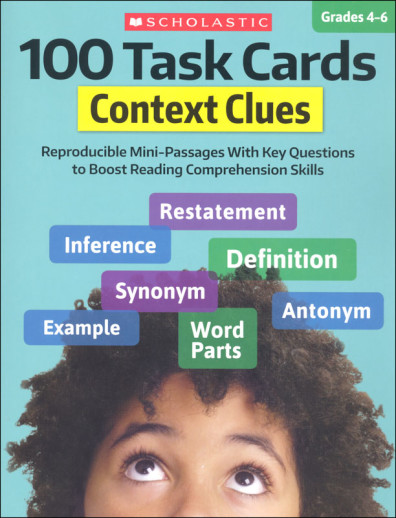We use cookies to make your experience better. To comply with the new e-Privacy directive, we need to ask for your consent to set the cookies. Learn more.
100 Task Cards: Context Clues
Give students the strategies they need to determine the meaning of new words encountered in text without turning to a dictionary! Each reproducible card contains a high-interest mini-passage and five key questions to hone this must-know skill-in just ten minutes a day. Cards provide guided support to help students use a range of context clues to arrive at a word's meaning. Includes a rich mix of fiction and nonfiction passages. A great way to boost standardized test scores!
Reading comprehension activities in two presentations: one is a workbook with 2 cards (really just paper) on a page that you cut out and answer the questions on directly. The other is a boxed set of actual cards with the same exact content as the workbook version. The workbooks are reproducible and the content is interesting. Your students will think it is fun to do reading comprehension. Each card is a half-page and numbered in the corner to help with planning. You'll find a short paragraph on the left side and 5 key questions on the right side. Use one as a daily warm-up, a morning basket activity, discuss over breakfast, or use in pairs/small groups for about 10 minutes each. Topics are funny and engaging: a bossy cousin Stella, exaggerated fishing stories, blubbery sealions, haggis, dogs burying their bones, Jackie Robinson, your body when you sleep, and loads more! If you're between 9 and 11 years old, these are hot topics. You will know that they are learning to effectively cite evidence, identify & apply literary elements, separate fact from opinion, and sequence events. Answers are in the back.
The Activity Cards – I can think of several situations where these boxes of reading comprehension activity cards would be helpful. Some examples include: anyone who has to take a standardized test and needs to prepare, in a classroom with centers of 1-3 students at a time, at home as a warm up before homeschooling, or at home as a quick independent learning activity. Do they align to CCSS? Yes, and they make no bones about it; but the content is good and something any ELA student could benefit from. I looked at the boxed set for Text Evidence tasks. Each box is separated into 3 groups: comprehension helper (definitions of terms with examples), informational text (non-fiction), and literary text (fiction). The definitions are clear, including terms such as cause & effect, compare & contrast, tone & theme, etc. The cards are large at 8" x 5" with rounded corners and come in a study storage box with flip-top lid. Each section is color-coded too. A student can study 2 or 3 cards a day and benefit from these sets in just minutes a day. Since they are non-consumable and sturdy, keep them for siblings or your next group of students. ~Sara
| Product Format: | Paperback |
|---|---|
| Brand: | Scholastic Teaching Resources |
| Grades: | 4-6 |
| ISBN: | 9781338603170 |
| Length in Inches: | 10.875 |
| Width in Inches: | 8.375 |
| Height in Inches: | 0.1875 |
| Weight in Pounds: | 0.45 |

